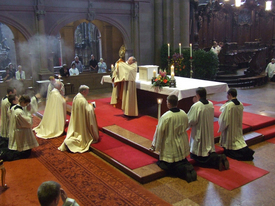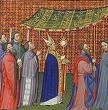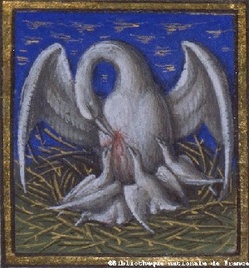 O sacred Banquet in which Christ is received, the memory of His Passion is recalled, the mind is filled with grace, and pledge of future glory is given to us.
O sacred Banquet in which Christ is received, the memory of His Passion is recalled, the mind is filled with grace, and pledge of future glory is given to us.
Tag: Corpus Christi
Corpus Christi
 Of the glorious Body telling,
Of the glorious Body telling,
O my tongue, its mystery sing,
and the Blood, all price excelling,
which the Gentiles’ Lord and King,
in a noble womb once dwelling,
shed for this world’s ransoming.
Given for us, for us descending
of a Virgin to proceed,
man with man in converse blending,
scattered He the gospel seed,
till His sojourn drew to ending,
which He closed in wondrous deed.
At the last great Supper lying,
circled by His brethren’s band,
meekly with the Law complying,
first He finished its command,
then, immortal Food supplying,
gave Himself with His own hand.
Word-made-flesh, by word He maketh
very bread, His Flesh to be;
man in wine Christ’s Blood partaketh,
and if senses fail to see,
faith alone the true heart waketh
to behold the mystery.
Therefore we, before Him bending,
this great Sacrament revere;
types and shadows have their ending,
for the newer Rite is here;
faith, our outward sense befriending,
makes the inward vision clear.
Glory let us give and blessing
to the Father and the Son;
honor, might, and praise addressing,
while eternal ages run,
ever too His love confession,
who from Both with Both is One.
Amen.
Lauda Sion
The Church has been given the gift of the enduring Presence of the Lord in the Eucharist. Last week celebrated Trinity Sunday and today Corpus Christi. This feast dates to when Pope Urban IV (1261-64) inaugurated the Feast of Corpus Christi and asked Saint Thomas Aquinas (1225-74) to compose the the Liturgy for the Church. A striking feature of today’s Liturgy is singing of a poetic called a sequence, one of four done in the current liturgical life of the Church, though historically there were poetics for all the major feast of the Lord and others for saints. Today’s marvelous sequence Lauda Sion,is sung prior to the proclamation of the Gospel. As all sacred texts do, Lauda Sion expresses Catholic faith in the Body and Blood of Christ. The three verses of Lauda Sion are given here but you may pray the entire text by visiting here.
Words a nature’s course derange,
that in Flesh the bread may change
and the wine in Christ’s own Blood.
Does it pass thy comprehending?
Faith, the law of light transcending,
leaps to things not understood.
Hail! Bread of the Angels, broken,
for us pilgrims food, and token
of the promise by Christ spoken,
children’s meat, to dogs denied!
Shown in Isaac’s dedication,
in the Manna’s preparation,
in the Paschal immolation,
in old types pre-signified.
Jesus, Shepherd mild and meek,
shield the poor, support the weak;
help all who Thy pardon sue,
placing all their trust in You:
fill them with Your healing grace!
Source of all we have or know,
feed and lead us here below.
grant that with Your Saints above,
sitting at the feast of love
we may see You face to face.
Amen. Alleluia.
I devoutly adore the Presence of Christ
Hidden God, devoutly I adore Thee, truly present underneath
these veils: all my heart subdues itself before Thee, since it all before Thee
faints and fails.
Not to sight, or taste, or touch be credit hearing only do
we trust secure; I believe, for God the Son has said it- Word of truth that
ever shall endure.
On the cross was veiled Thy Godhead’s splendor, here Thy
manhood lies hidden too; unto both alike my faith I render, and, as sued the
contrite thief, I sue.
Though I look not on Thy wounds with Thomas, Thee, my Lord,
and Thee, my God, I call: make me more and more believe Thy promise, hope in
Thee, and love Thee over all.
O memorial of my Savior dying, Living Bread, that gives life
to man; make my soul, its life from Thee supplying, taste Thy sweetness, as on
earth it can.
Deign, O Jesus, Pelican of heaven, me, a sinner, in Thy
Blood to lave, to a single drop of which is given all the world from all its
sin to save.
Contemplating, Lord, Thy hidden presence, grant me what I thirst for and implore, in the revelation of Thy essence to behold Thy glory evermore, Amen.






